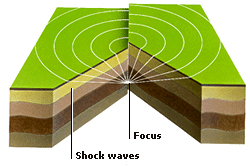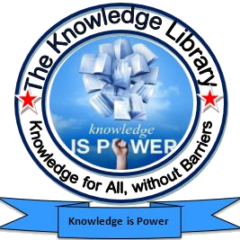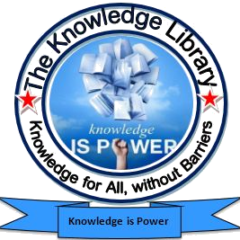Earthquakes are caused by movements of the giant tectonic plates that form Earth’s crust. SEISMOLOGY is the study of earthquakes. Most occur at cracks called FAULTS, at the boundaries where the plates meet. Every minute, the ground shakes somewhere in the world, but these vibrations are usually minor tremors that are barely noticed. When a major earthquake strikes, the ground shakes violently, and buildings and bridges topple.

As the plates slowly shift, rocks are put under pressure. They stick, then stretch and, as the strain gets too great, they shatter and jolt into new positions. Seismic (shock) waves radiate from the earthquake’s focus, underground. The epicenter, above the focus, suffers the worst damage.
Faults are deep cracks in rocks, mostly caused by movement at plate margins. Deep earthquakes strike in subduction zones where two plates collide and one slides below the other. Shallow earthquakes occur mostly where two plates grind past one another. The rocks may be shifted only a few centimeters, but over millions of years, this can add up to hundreds of kilometers of movement sideways, and up to 30 km (19 miles) of vertical movement.
The rocks along a fault may move up or down, sideways or diagonally, depending on the angle of the fault plane. The angle of the fault plane to the horizontal is known as the dip. In a normal fault, also known as a dip-slip fault, the rocks shift straight down or up, following the line of dip.
The distance that the rocks slip up or down during a quake or tremor is called the throw. In a reverse fault, pressure causes one block of rock to overhang another. As the rocks shift, the block is forced farther up and over the other. A reverse fault with a fault plane of 45° or less is called a thrust fault.
In a strike-slip fault, rocks scrape sideways past one another. The amount of sideways slip is called the heave. The San Andreas Fault, which runs along the west coast of North America, is a famous example. The rocks in an oblique-slip fault slide past each other, and also up and down in a diagonal movement.
Seismologists study earthquakes. They also examine the behavior of seismic waves passing through the Earth to find out about its structure. Instruments called seismographs measure the intensity of seismic waves. The magnitude (size) of earthquakes can be rated by measuring either these waves, on the Richter scale, or the damage caused – the Mercalli scale. Earthquakes cannot be prevented, but they can sometimes be accurately predicted.



 Users Today : 52
Users Today : 52 Total views : 665078
Total views : 665078